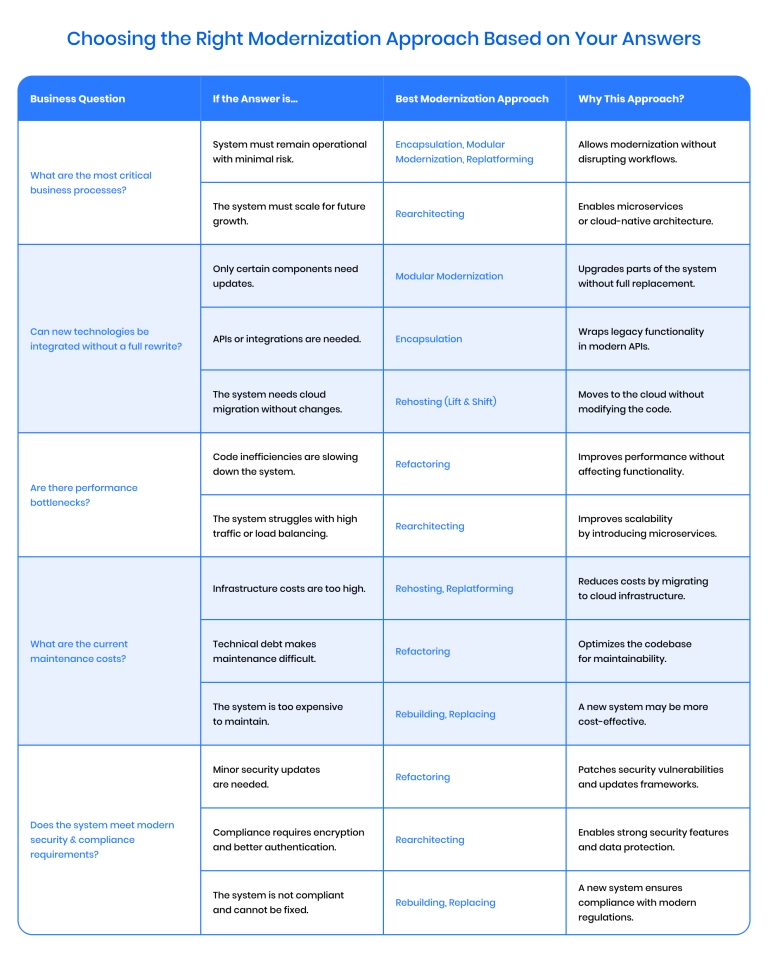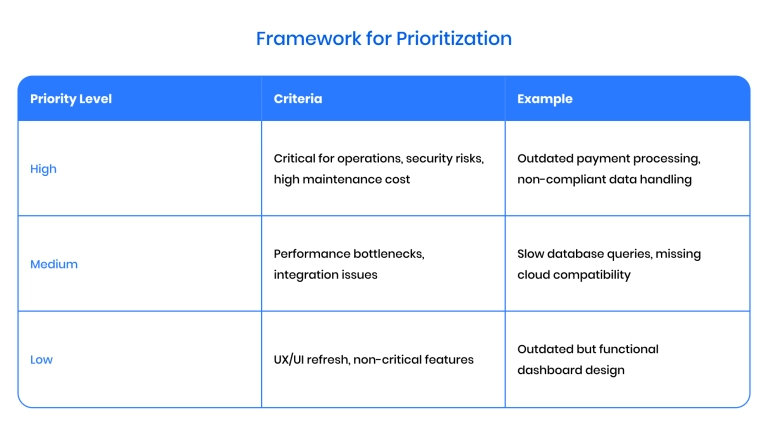Arriving at the end of legacy systems' life is a real problem for many businesses, as legacy systems are becoming outdated more rapidly than before due to rapid technological advancements and ever-evolving compliance demands. The time to modernize legacy systems comes inevitably.
Businesses using legacy systems face a critical decision: modernize or completely replace legacy applications. Maintaining outdated systems becomes increasingly costly and risky, with challenges including rising maintenance expenses, security vulnerabilities, limited performance, and difficulties integrating modern technologies.
Choosing to rebuild or modernize the legacy system is a challenge. But once you arrive at the right decision, there is even more planning to do. This article overviews legacy system modernization strategies and helps you determine the best approach. We also look into IT legacy modernization step-by-step, with budget planning.
What does legacy system modernization really mean?
Legacy system modernization involves upgrading existing software and IT infrastructure to improve performance and maintainability while optimizing costs. The system migrates to more flexible technologies. Depending on the scope and business needs, this could involve enhancements, partial upgrades, or even complete replacement.
Modernization doesn't always mean rewriting the system from scratch. Some systems are difficult to replace, especially if they carry vital processes. Instead of replacement, the modernization approach can involve:
- Updating architecture (migrating to microservices, containerization).
- Replacing outdated frameworks and technologies (upgrading libraries, moving to supported versions).
- Optimizing critical business processes (identifying bottlenecks in workflows).
- Integrating with cloud solutions (offloading certain functionalities to the cloud).
- Enhancing security & compliance (ensuring adherence to ISO, GDPR, HIPAA, SOC 2).
Companies that are undergoing IT legacy modernization typically face legacy system issues when:
- High maintenance costs – every change requires significant time and resources.
- Frequent failures or poor performance – patches are no longer enough.
- Security & compliance risks – outdated technologies = vulnerabilities.
- Loss of competitive advantage – new features take too long to implement.
Experiencing these issues usually indicates that the business will benefit from legacy system modernization. A legacy system does not have to be old to undergo modernization – it is enough for it to no longer meet business needs on a fundamental level.
Here are the key aspects of legacy software modernization:
1. Architecture upgrades
- Monolith to Microservices – Breaking down a monolithic system into smaller, independent services.
- Containerization – Deploying applications in containers (Docker, Kubernetes) for scalability.
- Cloud Migration – Moving parts of the system to AWS, Azure, or Google Cloud.
2. Framework & technology updates
- Replacing outdated libraries and frameworks (e.g., migrating from AngularJS to React, Java 8 to Java 17).
- Updating databases (e.g., shifting from relational DBs to NoSQL or cloud-native databases).
- Ensuring continued support and security patches.
3. Infrastructure modernization
- Migrating from on-premise servers to cloud or hybrid environments.
- Automating deployments using CI/CD pipelines (Jenkins, GitHub Actions).
- Implementing Infrastructure as Code (IaC) with Terraform or Ansible.
4. UI/UX enhancements
- Modernizing front-end technologies for better user experience.
- Implementing responsive design, accessibility, and performance optimization.
- Enhancing usability through intuitive workflows and updated design systems.
5. Integration and API modernization
- Replacing SOAP-based APIs with RESTful or GraphQL services.
- Implementing event-driven architecture (Kafka, RabbitMQ).
- Ensuring seamless third-party integrations.
Seven common approaches to modernizing legacy systems are encapsulating, rehosting (lift & shift), replatforming (lift, tweak, and shift), refactoring, rearchitecting, rebuilding, replacing, and modular modernization. Here is how these legacy system modernization strategies differ:
Modernization Strategy Comparison
| Approach | Definition | When to Use? | Example of Implementation |
| Encapsulation | Wrapping the legacy system with APIs or middleware to integrate with modern applications | When the business needs interoperability with new technologies without modifying core logic | A financial institution adds an API layer to its legacy banking system to enable integration with a modern mobile banking app |
| Rehosting ("Lift & Shift") | Moving the system to a cloud environment without changing its code | When quick cloud migration is needed to reduce infrastructure costs, but major changes are not required | A retail company moves its inventory management system from on-premise servers to AWS virtual machines to cut hosting costs |
| Replatforming ("Lift, Tweak & Shift") | Migrating to a new platform with minimal optimizations (e.g., containerization, managed cloud services) | When some performance or cost benefits are needed but without a full rewrite | An e-commerce platform moves its monolithic database to a managed cloud database service for improved scalability |
| Refactoring | Improving the internal structure of the existing code without changing its functionality | When the system works but has inefficiencies that slow development, security, or performance | A SaaS company optimizes its legacy application by removing redundant database queries and restructuring inefficient code |
| Rearchitecting | Changing the system's architecture to microservices, serverless, or cloud-native models | When the system needs better scalability, flexibility, or integration with modern applications | A streaming service transitions from a monolithic backend to microservices to improve video load times under high traffic |
| Rebuilding | Redesigning and reengineering the system while preserving core business logic | When the system is outdated but still holds valuable processes that need upgrading | A logistics company revamps its supply chain management software with modern UI, automation, and API integrations while keeping core workflows intact |
| Replacing | Replacing the entire system with a new custom-built or SaaS solution | When maintaining the old system is more expensive and inefficient compared to a new implementation | A healthcare provider replaces its outdated patient records system with a cloud-based HIPAA-compliant solution |
| Modular Modernization | Upgrading specific components of the system while keeping the core intact | When incremental improvements are preferred over full system replacement, reducing risks and disruptions | A telecom provider upgrades its billing module while keeping the existing customer management system unchanged |
Business considerations: How to decide?
Legacy system modernization should be guided by business needs, feasibility, and expected ROI. Below is a decision-based framework that helps you choose the right modernization approach based on your answers to key business questions.
1. What are the most critical business processes?
- Which system functionalities are essential for daily operations?
- What are the most frequently used workflows?
- Which processes generate the most revenue or add the most value?
- If the system fails, which operations would be disrupted first?
Why it matters: Identifying core business processes ensures that modernization efforts focus on areas with the highest impact.
If the answer is:
"Our system is business-critical, and we cannot afford any disruptions."
→ Pick: Encapsulation or modular modernization
"We need some performance improvements but can't change the core logic."
→ Pick: Replatforming
"Our system must scale to handle growing demand while maintaining uptime."
→ Pick: Rearchitecting (e.g., microservices, cloud migration)
Example: A financial services company relies on its transaction processing system 24/7, so encapsulation is used to integrate it with modern payment gateways instead of rewriting it.
2. Can new technologies be integrated without a full rewrite?
- Are there modular components that can be upgraded separately?
- Can legacy components be wrapped with APIs to integrate with modern solutions?
- Are there low-risk transition paths, such as adopting a hybrid cloud approach?
- Can microservices or containerization be introduced gradually?
Why it matters: Full system rewrites are expensive and risky. Incremental modernization allows businesses to adapt without disrupting operations.
If the answer is:
"Yes, but only some components need upgrades."
→ Pick: Modular modernization
"We need to integrate APIs but keep the core system."
→ Pick: Encapsulation
"We want to move to the cloud but without code changes."
→ Pick: Rehosting (lift & shift)
Example: An insurance company transitions its on-premise customer database to a cloud-based managed database (Replatforming) while keeping the core application intact. This allows better scalability and performance without a complete system rewrite during insurance legacy system transformation .
3. Are there performance bottlenecks in the system?
- Does the system struggle under high loads or peak usage?
- Are database queries and transactions slowing down processes?
- Is there a noticeable lag in user interactions or data retrieval?
- Could caching, indexing, or database sharding improve performance?
Why it matters: Poor performance leads to inefficiencies. Identifying bottlenecks can guide targeted optimizations.
If the answer is:
"The code is slow and inefficient, but the system works."
→ Pick: Refactoring
"Performance issues come from infrastructure limitations."
→ Pick: Replatforming or rehosting
"The system struggles with high traffic and load balancing."
→ Pick: Rearchitecting (e.g., microservices, cloud-native deployment)
Example: A subscription-based streaming service facing slow video load times and buffering issues implements Rearchitecting, transitioning from a monolithic backend to a microservices architecture. This allows independent scaling of video processing and user authentication, improving overall system performance under high traffic loads.
4. What are the current maintenance costs?
- How much time and budget are allocated to system maintenance?
- Are there increasing costs due to technical debt and outdated infrastructure?
- How much effort is required to onboard new developers onto the legacy system?
- Would modernization lower operational expenses in the long run?
Why it matters: If maintenance costs are growing faster than modernization costs, delaying an upgrade can be more expensive than acting now.
If the answer is:
"Infrastructure costs are too high."
→ Pick: Rehosting (lift & shift) or replatforming
"Technical debt is making maintenance difficult and expensive."
→ Pick: Refactoring
"Maintenance is more expensive than developing a new system."
→ Pick: Rebuilding or replacing
Example: If an old HR system is expensive to maintain and difficult for new developers to manage, Rebuilding or Replacing it with a modern cloud-based HR platform may be a better investment.
5. Does the system meet modern security & compliance requirements?
- Are outdated frameworks creating security vulnerabilities?
- Does the system comply with industry regulations (GDPR, HIPAA, SOC 2)?
- Are legacy authentication methods exposing sensitive data?
- Have security audits revealed weaknesses in access control or encryption?
Why it matters: Compliance violations can lead to legal risks, financial penalties, and reputational damage. Upgrading security is often a non-negotiable factor in modernization.
If the answer is:
"Security patches are missing, but the system is still functional."
→ Pick: Refactoring
"Compliance requires stronger encryption and authentication."
→ Pick: Rearchitecting
"The system cannot meet modern security standards."
→ Pick: Rebuilding or replacing
Example: A healthcare provider handling sensitive patient data must comply with HIPAA regulations and rebuild its patient record system with secure encryption and authentication.

Technical steps for legacy systems modernization
1. Conduct a system audit & assessment
Before choosing a legacy modernization approach, businesses must evaluate their legacy systems and IT infrastructure to make sure that modernization efforts focus on high-impact areas. Namely, they should:
1. Assess business & IT drivers
Business drivers:
- Business fit – Does the application align with current business goals?
- Business value – Does the application contribute significant value?
- Business agility – Can it adapt to modern business demands?
IT drivers:
- IT cost – Is the total cost of ownership (TCO) too high?
- Application & implementation complexity – Does it require excessive effort to maintain?
- Risk – Does it pose security, compliance, or operational risks?
- Build a comprehensive application inventory
2. Catalog all legacy applications, including:
- Name, version, purpose, and functionality
- Dependencies, business importance, compliance risks
- Code complexity, performance bottlenecks, and security concerns.
Note: Be sure to engage stakeholders early in the process for proper planning. Developers alone can't assess optimization potential; business analysts must map how processes interact with the system.
You should identify the most used and critical processes at this first stage. The most actively used components are where the legacy application modernization will have the biggest impact. It is best to start from them.
2. Define the modernization strategy
Based on the audit, select a modernization approach:
- Encapsulation – Wrapping legacy systems with APIs or middleware to extend capabilities without modifying core logic.
- Rehosting ("lift & shift") – Moving the system to a new infrastructure without code changes.
- Replatforming ("lift, tweak & shift") – Migrating to a modern platform with minor optimizations (e.g., containerization).
- Refactoring – Optimizing existing code to improve performance, security, and maintainability.
- Rearchitecting – Changing the system architecture (e.g., monolith to microservices, serverless, cloud-native models).
- Rebuilding – Redesigning and reengineering the system while preserving core business logic.
- Replacing – Fully replacing the legacy system with a new custom-built or SaaS solution.
- Modular modernization – Upgrading specific components while keeping the core system intact.
3. Modularization & API implementation (if applicable)
Relevant for: Encapsulation, Rearchitecting, Modular Modernization
- Identify independent services that can be modularized.
- Develop APIs or middleware to enable communication between old and new components.
- Use API gateways or event-driven architecture to bridge legacy and modern systems.
Data inventory & mapping:
- Identify how data is stored and used across applications.
- Determine if certain data should be migrated, archived, or eliminated.
- Ensure data remains secure and accessible throughout modernization.
This step prevents critical data loss and ensures business continuity during migration.
4. Migrate to a modern technology stack
Relevant for: Replatforming, Rearchitecting, Rebuilding, Replacing
- Upgrade databases (e.g., Oracle → PostgreSQL or MongoDB).
- Replace outdated programming languages (e.g., COBOL, VB6 → Java, Python, .NET Core).
- Shift to scalable cloud environments (AWS, Azure, GCP).
At this step, it is essential to prioritize simplicity in architecture, namely:
- Avoid replicating overly complex legacy architectures.
- Consider a microservices or modular approach for scalability.
- Focus on integration with existing tools and business systems.
5. Strengthen security & compliance
Relevant for: All strategies, but critical for Replatforming, Rearchitecting, Rebuilding, and Replacing
- Implement multi-factor authentication (MFA).
- Encrypt sensitive data (in transit & at rest).
- Conduct penetration testing and vulnerability assessments.
- Ensure compliance with GDPR, HIPAA, and SOC 2.
6. Deploy & monitor in stages
Phased rollout varies by legacy modernization approach:
- Encapsulation & modular modernization → Incremental deployment of modernized components alongside the legacy system.
- Rehosting & replatforming → Migrate workloads gradually with rollback options (e.g., blue-green or canary deployment).
- Refactoring & rearchitecting → Deploy module by module, using CI/CD pipelines and feature toggles.
- Rebuilding & replacing → Phased migration or full cutover, depending on operational risk.
Monitoring & feedback loop (for all approaches):
- Use APM tools (New Relic, Datadog) for real-time tracking.
- Gather user feedback and refine it based on performance insights.
7. Establish a retirement plan for legacy systems
- Maintain support for legacy systems until the modern system is fully stable.
- Archive legacy data securely.
- Document best practices for future modernizations.
8. Train employees on new systems
- Provide hands-on training sessions and workshops.
- Use Digital Adoption Platforms (DAPs) like Whatfix or WalkMe for in-app guidance.
- Develop self-service user manuals and guided walkthroughs.
The cost factor: Budgeting & ROI
Modernizing a legacy system requires a well-planned financial strategy. Businesses must assess the total cost of ownership (TCO), compare maintenance expenses with modernization costs, and determine which upgrades yield the highest return on investment (ROI).
The cost of modernizing legacy systems depends on system complexity, infrastructure, and chosen strategy. Cost estimation methodologies help businesses predict expenses and effort accurately. Here are some popular cost estimation models you may apply
- COCOMO (Constructive Cost Model) – Uses lines of code (LOC) to estimate effort based on team size, experience, and system complexity.
- FPA (Function Point Analysis) – Estimates cost based on functional requirements rather than raw code size, useful for business-driven assessments.
- Putnam Model – Predicts project time and effort based on historical project data, allowing businesses to refine estimates dynamically.
Key cost components:
- Development & engineering costs – Time and resources for refactoring, migrating, or rewriting code.
- Infrastructure costs – Expenses for cloud migration, on-prem upgrades, or hybrid models.
- Licensing & software costs – New tools, frameworks, databases, and third-party integrations.
- Security & compliance – Ensuring adherence to regulations (GDPR, HIPAA, SOC 2).
- Training & adoption – Educating teams on new technologies and workflows.
Pro tip: Use a phased approach to spread costs over time rather than making a significant one-time investment.
Cost of maintenance VS. cost of modernization
Many businesses hesitate to modernize due to high upfront costs. However, delaying modernization can be more expensive due to:
- Technical debt – Maintaining outdated code becomes costly and inefficient over time.
- Downtime & performance issues – Legacy systems slow productivity and can lead to outages.
- Security vulnerabilities – Non-compliance increases risk exposure and potential fines.
- Integration challenges – Outdated systems struggle with APIs and cloud solutions.

How to prioritize modernization investments?
Not every component needs immediate modernization. Businesses should prioritize based on the following:
- Critical business impact
- Long-term cost savings
- Security risk factors
- Scalability

Calculating ROI for modernization
To justify modernization investments, businesses must measure cost savings vs. revenue gains.
ROI calculation formula:
(Cost Savings + Revenue Gains) / Investment Cost = ROI %
Example calculation:
- Before modernization: $500K annual maintenance cost, $50K lost revenue due to downtime.
- After modernization, there was a $200K maintenance cost and $0 downtime loss.
- Investment cost: $600K over 2 years.
- This leaves ROI Calculation at ($350K savings per year x 2 years) / $600K investment = 116% ROI in 2 years.
For successful ROI-driven modernization, start with low-hanging fruit that delivers immediate value, avoid full rewrites, and monitor all KPIs for results.
Case studies: When modernization works best
Below are real-world case studies of legacy system modernization or rebuilding:
Kela: Finnish Social Security Institution – Mainframe Rehosting
Kela, responsible for Finland's social security programs, operated legacy mainframe systems that were expensive to maintain and difficult to upgrade due to a shortage of skilled COBOL developers.
The legacy modernization strategy they used is rehosting:
- Kela used TmaxSoft's OpenFrame to migrate over 10 million lines of COBOL code from the mainframe to a Linux-based environment (Source ). They opted for business logic preservation with retained core processes.
- As a result, the company:
- Lowered system maintenance expenses.
- Enabled existing IT staff to manage the new system without extensive retraining.
- Improved scalability to support future service expansions.
NASA: Modernization of the Astrophysics Data System (ADS)
NASA's Astrophysics Data System (ADS), the primary digital library for researchers in astronomy and astrophysics, relied on a 30-year-old monolithic infrastructure (Source ). The system faced scalability challenges, slow data retrieval, and difficulties integrating modern systems, so it was due for an overhaul.
- NASA transitioned from a monolithic architecture to a cloud-based microservices framework.
- The legacy system replacement strategy involved advancing search capabilities. The company implemented modern search engines and APIs.
- The IT legacy modernization involved machine learning integration. Natural Language Processing (NLP) and Machine Learning (ML) were used to improve metadata enrichment and search functionality.
The outcomes of legacy software modernization included:
- Improved system uptime and faster data retrieval
- Enhanced research capabilities with AI-driven search features
- Future-ready infrastructure
Conclusion & next steps
Selecting the right approach and sticking to the plan are keys to modernizing your legacy systems effectively. The companies that need replacing and those that will benefit from modular modernization are very different, and business considerations should carefully guide your choice of strategy.
Modernization is a strategic decision the business should commit to. Working with partners like Binariks is a great choice here, as we have the technical expertise to transition smoothly to the new system. Here is what we can do:
- Assess business & tech needs – Identify key workflows, tech stack issues, and cost-saving opportunities.
- Modernize without full rewrite – Rehost, replatform, or upgrade select components.
- Enable API integration – Connect legacy systems with modern apps.
- Migrate to cloud – Move to AWS, Azure, or Google Cloud while keeping core functions.
- Upgrade security & frameworks – Replace outdated tech and fix vulnerabilities.
- Adopt microservices – Break monoliths into scalable services.
- Align business & IT – Connect analysts, developers, and security teams.
- Ensure compliance – Meet GDPR, HIPAA, and SOC 2 with security upgrades.
- In addition, we offer software product development services , platform development services , and software architecture consulting .
Share

